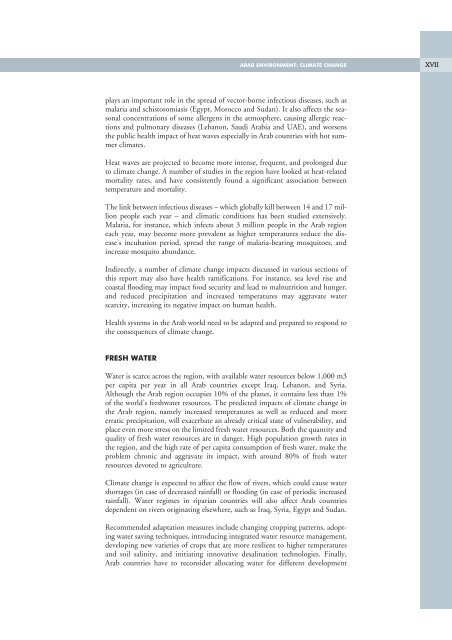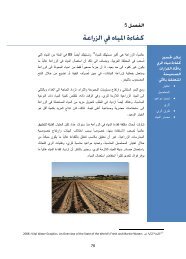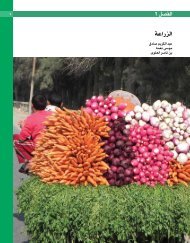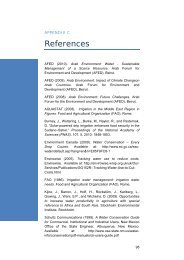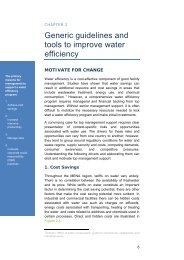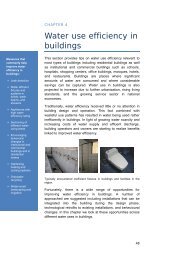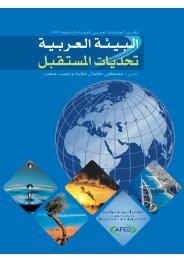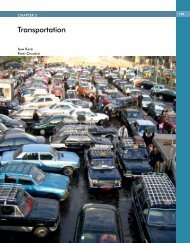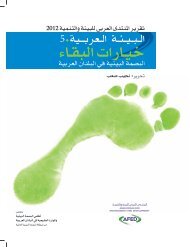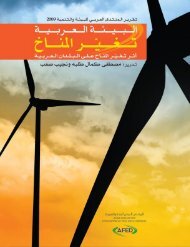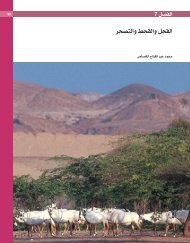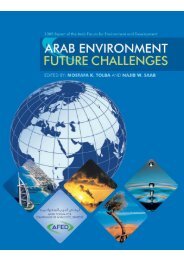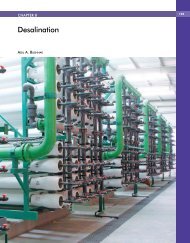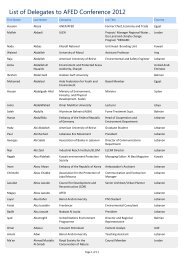Impact of Climate Change on Arab Countries - (IPCC) - Working ...
Impact of Climate Change on Arab Countries - (IPCC) - Working ...
Impact of Climate Change on Arab Countries - (IPCC) - Working ...
Create successful ePaper yourself
Turn your PDF publications into a flip-book with our unique Google optimized e-Paper software.
ARAB ENVIRONMENT: CLIMATE CHANGE<br />
XVII<br />
plays an important role in the spread <str<strong>on</strong>g>of</str<strong>on</strong>g> vector-borne infectious diseases, such as<br />
malaria and schistosomiasis (Egypt, Morocco and Sudan). It also affects the seas<strong>on</strong>al<br />
c<strong>on</strong>centrati<strong>on</strong>s <str<strong>on</strong>g>of</str<strong>on</strong>g> some allergens in the atmosphere, causing allergic reacti<strong>on</strong>s<br />
and pulm<strong>on</strong>ary diseases (Leban<strong>on</strong>, Saudi <strong>Arab</strong>ia and UAE), and worsens<br />
the public health impact <str<strong>on</strong>g>of</str<strong>on</strong>g> heat waves especially in <strong>Arab</strong> countries with hot summer<br />
climates.<br />
Heat waves are projected to become more intense, frequent, and prol<strong>on</strong>ged due<br />
to climate change. A number <str<strong>on</strong>g>of</str<strong>on</strong>g> studies in the regi<strong>on</strong> have looked at heat-related<br />
mortality rates, and have c<strong>on</strong>sistently found a significant associati<strong>on</strong> between<br />
temperature and mortality.<br />
The link between infectious diseases – which globally kill between 14 and 17 milli<strong>on</strong><br />
people each year – and climatic c<strong>on</strong>diti<strong>on</strong>s has been studied extensively.<br />
Malaria, for instance, which infects about 3 milli<strong>on</strong> people in the <strong>Arab</strong> regi<strong>on</strong><br />
each year, may become more prevalent as higher temperatures reduce the disease’s<br />
incubati<strong>on</strong> period, spread the range <str<strong>on</strong>g>of</str<strong>on</strong>g> malaria-bearing mosquitoes, and<br />
increase mosquito abundance.<br />
Indirectly, a number <str<strong>on</strong>g>of</str<strong>on</strong>g> climate change impacts discussed in various secti<strong>on</strong>s <str<strong>on</strong>g>of</str<strong>on</strong>g><br />
this report may also have health ramificati<strong>on</strong>s. For instance, sea level rise and<br />
coastal flooding may impact food security and lead to malnutriti<strong>on</strong> and hunger,<br />
and reduced precipitati<strong>on</strong> and increased temperatures may aggravate water<br />
scarcity, increasing its negative impact <strong>on</strong> human health.<br />
Health systems in the <strong>Arab</strong> world need to be adapted and prepared to resp<strong>on</strong>d to<br />
the c<strong>on</strong>sequences <str<strong>on</strong>g>of</str<strong>on</strong>g> climate change.<br />
FRESH WATER<br />
Water is scarce across the regi<strong>on</strong>, with available water resources below 1,000 m3<br />
per capita per year in all <strong>Arab</strong> countries except Iraq, Leban<strong>on</strong>, and Syria.<br />
Although the <strong>Arab</strong> regi<strong>on</strong> occupies 10% <str<strong>on</strong>g>of</str<strong>on</strong>g> the planet, it c<strong>on</strong>tains less than 1%<br />
<str<strong>on</strong>g>of</str<strong>on</strong>g> the world’s freshwater resources. The predicted impacts <str<strong>on</strong>g>of</str<strong>on</strong>g> climate change in<br />
the <strong>Arab</strong> regi<strong>on</strong>, namely increased temperatures as well as reduced and more<br />
erratic precipitati<strong>on</strong>, will exacerbate an already critical state <str<strong>on</strong>g>of</str<strong>on</strong>g> vulnerability, and<br />
place even more stress <strong>on</strong> the limited fresh water resources. Both the quantity and<br />
quality <str<strong>on</strong>g>of</str<strong>on</strong>g> fresh water resources are in danger. High populati<strong>on</strong> growth rates in<br />
the regi<strong>on</strong>, and the high rate <str<strong>on</strong>g>of</str<strong>on</strong>g> per capita c<strong>on</strong>sumpti<strong>on</strong> <str<strong>on</strong>g>of</str<strong>on</strong>g> fresh water, make the<br />
problem chr<strong>on</strong>ic and aggravate its impact, with around 80% <str<strong>on</strong>g>of</str<strong>on</strong>g> fresh water<br />
resources devoted to agriculture.<br />
<str<strong>on</strong>g>Climate</str<strong>on</strong>g> change is expected to affect the flow <str<strong>on</strong>g>of</str<strong>on</strong>g> rivers, which could cause water<br />
shortages (in case <str<strong>on</strong>g>of</str<strong>on</strong>g> decreased rainfall) or flooding (in case <str<strong>on</strong>g>of</str<strong>on</strong>g> periodic increased<br />
rainfall). Water regimes in riparian countries will also affect <strong>Arab</strong> countries<br />
dependent <strong>on</strong> rivers originating elsewhere, such as Iraq, Syria, Egypt and Sudan.<br />
Recommended adaptati<strong>on</strong> measures include changing cropping patterns, adopting<br />
water saving techniques, introducing integrated water resource management,<br />
developing new varieties <str<strong>on</strong>g>of</str<strong>on</strong>g> crops that are more resilient to higher temperatures<br />
and soil salinity, and initiating innovative desalinati<strong>on</strong> technologies. Finally,<br />
<strong>Arab</strong> countries have to rec<strong>on</strong>sider allocating water for different development


